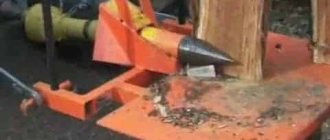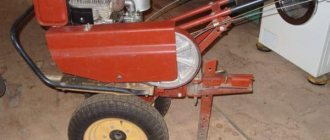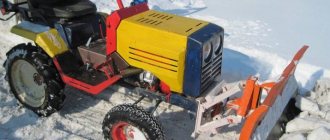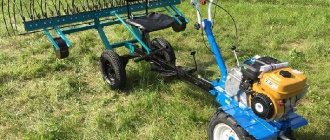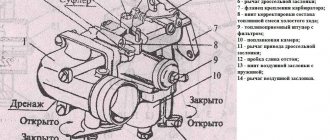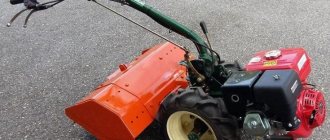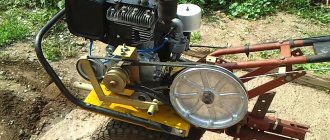Wood splitter for walk-behind tractor
Motoblocks today have become the equipment that combines the capabilities of different tools both for plowing the land and for performing other work on caring for a personal plot. By purchasing such a unit, you can not only complete work faster, but also preserve your health. Chopping firewood is a fairly simple job, but only at first glance. If you need a lot of firewood, then even the strongest man can quickly become exhausted, not to mention older people. You can make firewood very quickly and without much effort thanks to a wood splitter for a walk-behind tractor.
What is a wood splitter on a walk-behind tractor?
Making a wood splitter from a walk-behind tractor is very simple. You just need to buy a ready-made set of tools and attach it to the machine. It is very easy to operate such a design, but there are some nuances. However, first things first.
So, the wood splitter for a walk-behind tractor has a screw design, which is very convenient and practical for preparing firewood at home. At the same time, it has very compact dimensions, as well as light weight - about 20 kilograms. It is attached directly to the walk-behind tractor and operates via a belt mounted on the PTO. The operating principle is very simple. Thanks to the belt, the cone begins to rotate. You need to bring a log to it, which will grab the cone. With a little effort on your part, namely pressing the log towards the cone, it will split. That is, you will no longer need any axes or saws.
Self-Build Plan
- First, you will need to weld the apparatus frame from a profile pipe with a cross-section of 60x40x2 mm.
- A cover made of sheet steel with a thickness of at least 5 mm should be welded to the top of the frame (after all, it will bear a large load).
- An electric motor and starting equipment for it should be placed at the bottom of the frame (it should be noted that the electrical circuit of the wood splitter must be equipped with an RCD).
- The drive pulley should be secured to the motor shaft.
- On the tabletop itself there is a mounting base for the “carrot” axis (the latter is seated on two bearings), and a driven pulley is fixed at the end of the axis (both pulleys should be selected in such a way that the final speed of the cone is around 500 rpm) .
- A steel wedge is welded under the working cone on the tabletop, which will protect the device from jamming.
- The most important part of the wood splitter that will have to be made is the working cone. To make it, you will need a lathe and a round piece of carbon steel of large diameter. Let us immediately note that recommendations on the Internet that talk about the possibility of making threads on a cone with an angle grinder are not only harmful (since such a thread will not provide the required moment to the log being split), but also extremely dangerous. If you don’t have a lathe, you can purchase a ready-made “carrot” or order its production.
Do-it-yourself cone wood splitter for a walk-behind tractor
So, using this drawing and armed with a steel blank and a lathe, let’s start turning the cone ourselves. When your workpiece finally takes the shape of a cone, you should cut a left-hand thrust thread onto it. To assemble a cone log splitter, you will need:
- Cone;
- Electric motor;
- Flange with a motorcycle sprocket from a wheel or shaft;
- Drive chain or passes;
- Shaft;
- Bearings;
- Bolt or pin (at your discretion);
- Supports for the shaft (Zhiguli cardan supports are ideal).
There are some nuances:
- The walk-behind tractor must be powerful enough to cope with such difficult work. The best option would be models with a power of 8 horsepower;
- Safety rules must be strictly followed. There is no need to forcefully push small logs towards the rotating cone, as there is a risk of injury;
- the log should have a diameter of no more than 45 centimeters.
It should also be noted that the design of the wood splitter for the walk-behind tractor also has a stand. This is where you should place the logs. In this case, the table legs are adjustable depending on the height of your unit. For greater stability while working, you can place a large log under the table to get rid of unnecessary vibration and stress, especially if you want to chop very large logs.
As can be seen from all of the above, a wood splitter is a very practical device that will not take up much space, will not require you to have certain knowledge and skills in its management, or even special financial expenses. Before use, be sure to read the instructions to ensure that the tool is compatible with your unit.
Electric wood splitters
A manual wood splitter, of course, makes it easier to prepare firewood, but it still requires considerable physical effort. Not as much as they are spent waving a regular cleaver, but still... The electric motor helps make the effort even less. Wood splitters of various designs are made on its basis. But making such a wood splitter with your own hands is more difficult. Here the device is more complex, and at least minimal knowledge of electrics is required - it is advisable to connect the motor through a starter, with “start” and “start” buttons.
Screw (conical)
One of the most common models is a cone or screw splitter. The only difference between them is the absence/presence of threads on the piercing element, which in this model is made in the form of a cone.
The cone splitter speeds up the preparation of firewood
The logs split due to the fact that a cone rotated by a motor cuts into the wood, gradually tearing it into pieces. For large logs, first the edges are chipped off, then the middle is torn.
Taper and thread parameters
First, the cutting part was turned into a smooth cone. If you use a smooth cone, when working you have to lean quite hard on the block so that the cylinder “bites” into the wood. The process is much easier if a thread is cut on its surface. In this case, the block seems to be screwed onto a screw, and then splits.
Drawing with dimensions of a cone with thread for a screw log splitter
The main thing is to make the cone with thread correctly. If you have a lathe and work experience, you can try to do it yourself. If not, you'll have to order it. The threads are made in different ways, but the following parameters are considered optimal: pitch 7 mm, depth 3 mm (minimum 2 mm). Another important point is that the depth of the seat on the motor gearbox is at least 70 mm.
Wood splitter screw
If you have a cone with a thread, making this wood splitter with your own hands will not be difficult.
Electric motor and gearbox
You need an electric motor that is powerful enough (2 kW and above, or 5-9 l/s), but with a low rotation speed: 250-600 rpm. At 250 rpm and below it chops very slowly, and if the rpm is more than 500, it is dangerous to work, as it can tear the log out of your hands.
Wood splitter with a screw mounted directly on the crankshaft
If you manage to find an engine with such parameters, you can attach the made lance (screw) directly to the crankshaft (pictured above). If there are more revolutions, you need to install a reduction gear or make a chain or belt drive to reduce the rotation speed.
The ratio is calculated depending on the engine speed. For example, there is a 900 rpm engine. By making a 1:2 gearbox we get 450 rpm. Just the best option.
Reducing gearbox for screw log splitter
Transmissions can be belt or chain. Chain ones work many times louder, require constant brushing, and it usually costs more to grind sprockets with the required parameters. A double belt drive is desirable (as in the photo above). In this case, there will be less slippage.
Where to place the motor
If the design includes a gear, it is better to place the motor at the bottom and secure the screw itself on the working surface. Choose the height of the working surface to suit your height so that you don’t have to work at an angle.
A safer model. Making such a wood splitter with your own hands will make your life much easier
There is also such a parameter as the height of the screw above the working surface. The gap from the table to the cylinder should be around 8-20 cm. It should not be placed higher - it may turn small diameter logs. The optimal distance is 8-12 cm. Even small-sized logs do not rotate.
Hydraulic wood splitter
A hydraulic wood splitter is the most powerful, but also the most complex and expensive to manufacture. In addition to the frame, engine and cutting knives, you need a hydraulic cylinder of sufficient power. They are not cheap. In addition, you also need an oil tank and a pump.
Hydraulic splitter device
A hydraulic firewood splitter develops considerable forces, which is why metal of considerable thickness is used in its manufacture - 6-10 mm, depending on the drive power. The developed force is quite enough to break the log into 6-8 logs at a time. That’s why knives are made in the shape of a “star”.
The hydraulically driven splitter is equipped with a complex cutter, which splits the log into several logs at once
When making knives, they are spaced several centimeters apart from each other. So that there is only one at work. For example, first - horizontal, then - vertical, then - right and finally - left. At the same time, strengthen each of the knives by welding reinforcing plates at the back. It is advisable to use hard steel, having previously sharpened it according to the same principle as for cleavers.
Wood splitter for walk-behind tractor
It is no secret that walk-behind tractors are most often considered as units for cultivating land.
Many owners of such technical developments have no idea that the machine can be used not only for plowing the soil, cultivating and cleaning the territory, but also for collecting firewood in the winter. This addition is very useful, because standing in the cold and trying to split wood yourself is not particularly pleasant. Using a cone log splitter, you can get several small logs from a walk-behind tractor in just a few minutes.
Classification of wood splitters by area of application
The dimensions and principle of operation of the device for chopping wood depend on the scope of its application. So, for example, at construction sites and sawmills you can often find a rather bulky but powerful wood splitter, and in private homes - a small compact homemade splitter.
According to the scope of application, splitting axes can be classified as follows:
- the log is placed in a chute, which is located opposite the knife, the length and width of the chute can be adjusted depending on the size of the log;
- The main element of the cleaver is the piston. He pushes the log and it moves forward;
- the piston pushes the log, after which the knife comes into action, which cuts the log into pieces of the required size;
- the log is fixed in a stationary position, and the knife moves back and forth and cuts the log into pieces.
A wood splitter is an indispensable assistant. The main disadvantage of the so-called household splitter is that it cannot be used for processing large logs. Before splitting a large log, it needs to be cut into several parts.
READ MORE: Best iPhone in 2022: which iPhone is better to buy? 10 best iPhone smartphones
How to make a wood splitter from a walk-behind tractor with your own hands?
In principle, creating a mounted wood splitter on a walk-behind tractor is not so difficult; the main thing is to have the necessary elements on hand, serious skills, experience and a responsible approach to the design and installation process.
The specified drawing should be used as a basis. To get a high-quality homemade wood splitter, you need a steel blank and a lathe. After turning the cone, a left-hand thrust thread should be cut onto it.
To assemble a wood splitter you need:
In the process of obtaining a full-fledged mechanical wood splitter, it is necessary to securely fix the threaded cone on the shaft. It is important that the bearings are the same size.
In order to see with your own eyes the process of assembling the considered attachments, you should familiarize yourself with the videos in which the craftsmen demonstrate their achievements and give useful advice to all interested persons.
If the cone gets stuck in a log, there is no need to panic, but use a regular wrench. Having unscrewed the damaged part, you can try to continue working.
An important point: the design of the wood splitter also consists of a stand on which logs are placed. This can be an ordinary iron board, but special attention must be paid to its stability so that it does not jump out due to strong vibration during operation.
What rules must be followed when operating a wood splitter?
- First, you need to carefully check the level of belt tension, the reliability of the cones and all bolts;
- Don't forget about eye protection;
- Wear only hard shoes that will protect your feet from falling parts of the ridge;
- Keep your hands as far away from the shaft as possible;
- Do not attempt to open cracks by hand as this may cause injury;
- Wear only close-fitting clothing;
- Do not use mittens during this process.
An independent attempt to create a wood splitter for a walk-behind tractor can only be successful if a person has the necessary tools and experience in this matter. It is not worth starting the development of design abilities from the creation of this hitch.
Although the wood splitter itself is a very useful device that can make life much easier and save the owner of a country house or cottage from unnecessary hassle.
How to choose?
Choosing the right gear unit means guaranteeing the overall reliability of the system and its long-term operation. If you make the slightest mistake, you will have to spend money on repairs or replacement of any part at the most important moment. In the worst case, you will have to change the elements interconnected with the broken part.
Therefore, it is very important to use the help of professional designers and engineers
They pay attention to a variety of factors:
- placement of the gearbox in space;
- its mode of operation;
- general load level;
- the temperature to which the device heats up;
- the type of tasks performed and the degree of their responsibility.
However, obtaining advice from engineers is not always possible in practice. In this case, the simplest recommendations that will be discussed below can help you out.
How to make a wood splitter with your own hands from a walk-behind tractor
A walk-behind tractor is already a familiar technique for residents of private homes. It can significantly simplify life, help with gardening and more. This is a universal technique that allows you to endlessly expand the scope of its application due to replaceable attachments. Recently, a wood splitter for walk-behind tractors has gained popularity. This convenient and quite inexpensive unit will save a lot of time and health, and relieve you of hard and boring work.
Harvesting firewood seems easy only at first glance. To chop firewood you need to have considerable strength and endurance. And winter always comes and does not care about age or the strength and ability to prepare firewood for a boiler, stove or fireplace. A wood splitter for a walk-behind tractor is a simple and convenient device that even a teenager can handle.
Specifics of the wood splitter
The wood splitter for the walk-behind tractor is an attachment that can be combined with all heavy models of units. It is often installed on walk-behind tractors Neva, Zubr, Agro and others. There are only two restrictions on the use of this attachment:
- The motor must have a water cooler;
- Minimum power from 8 liters. With.
The equipment has a standard design:
- the presence of a powerful metal cone with a screw thread and a thin sharp tip on the frame;
- the nozzle moves due to the belt from the power take-off shaft. After switching on, the shaft begins to rotate, the cone screws into the log and divides it. When starting work, the tree must be held until the shaft is completely screwed into the wood;
- the presence of an adjustable table for ready-made firewood.
Principle of operation
It’s not for nothing that they say that everything ingenious is simple. This fully characterizes the operating principle of a wood splitter from a walk-behind tractor. This is an attachment that is very easily attached to the walk-behind tractor. The wood splitters are compatible with all heavy models of walk-behind tractors and some light ones. Most often, a wood splitter is used on the Neva walk-behind tractor. But can be used with other models. There are only two restrictions: the walk-behind tractor engine must be water-cooled and its power must be at least 8 hp. With.
Its design allows you to split firewood of any species. The only limitation is that the diameter of the log should be no more than 45 cm.
Features of a hydraulic wood splitter with a walk-behind tractor engine
Hydraulic splitting axes are another equally popular solution. The hydraulic wood splitter made from a walk-behind tractor has a classic horizontal layout based on an immobilized frame.
Such a unit is controlled automatically, so you need to provide a trigger mechanism - a special button connected to the cylinder and the oil tank. The moment it is pressed, the process of pumping liquid into the cylinder cavity starts. Expanding, it hits the persistent heel (pusher), moving it in the desired direction.
Assembly progress:
- We fix the hydraulic jack on a stationary support;
- At the opposite end of the support we place wedge-shaped knives;
- We assemble the jack with a gasoline or diesel engine;
- We supplement the device with return springs, which will return the jack to its original position;
- Testing a wood splitter.
Advantages and disadvantages of homemade wood splitters based on a walk-behind tractor
Advantages:
- Do-it-yourself wood splitters from a walk-behind tractor make the lot easier for owners of private houses, summer cottages, and professional forest harvesters;
- Simplicity of design and maintenance;
- Possibility of creating a wood splitter to suit personal requirements;
- Transportability;
- Budget - the full cost of using scrap materials will be an order of magnitude cheaper than the factory one.
Flaws:
- Injury hazard;
- Fragility of nodes and their connections.
Features of operation
Like any equipment, a splitter for a walk-behind tractor (this is also called a wood splitter) requires mandatory compliance with safety standards. The wood splitter shaft of the walk-behind tractor rotates quite quickly (about 500 rpm), has a thread and a sharp tip. Failure to follow safety precautions can result in serious injury.
Therefore, when starting to chop wood, you should follow these simple rules:
- Before you start work, you need to check the belt tension, the fastening of the cone and all bolts. If necessary, their tension must be adjusted. You also need to control this during the work process.
- Wear eye protection.
- Shoes should be tough, able to protect if a log falls on your foot.
- You should not chop wood wearing mittens, because with the slightest carelessness, the mitten or glove can get wrapped around the shaft along with your hand.
- Work clothes should not hang loosely.
- When working with a wood splitter, it is necessary to keep your hands as far as possible from the shaft and from cracks that form on the log, as this can lead to injury.
Types of manual wood splitters
The most popular are manual wood splitters (also called kinetic), which operate using simple physical principles and do not require special physical capabilities. Here are the main types of devices:
crowbar cleaver (the log on which the cleaver is installed is split with a sharp forward movement using a special crowbar rod);
Wood splitter
spring (there is a lever of force, the method of a weighted working element is used);
Do-it-yourself spring-loaded manual wood splitter
- with a manual drive (there is a special cabinet with a blade oriented upward on it. The log is placed on the blade and is easily split in two using, for example, a sledgehammer);
- rack and pinion (there is a special rack with notches, which is a pushing element).
Homemade rack and pinion wood splitter Tool for splitting firewood with a foot pedal
If you often heat with wood, you have already repeatedly encountered the problem of procuring it. To simplify the process as much as possible, you can use manual mini-wood splitters - such as Greenween, Strela, Kolundrov. Such devices will help you quickly and efficiently split the most “complicated” logs, and even women (including the elderly) can operate them.
It is convenient to use such mini-wood splitters. Even women can use such a wood splitter
Greenween
The device has basic and multifunctional modifications. But the device in both cases is identical: a wide blade made of high-strength steel is fixed to the frame. Ribs are melted onto the edges of the blade - special hard plates that separate the cracked log into parts.
Photo of Greenween wood splitter GreenWeen wood splitter
Important Technical characteristics of the universal tractor YuMZ-6 and its popular modifications
The basic model differs from the multifunctional one in the diameter of the lumps that can be split. With the help of the second version of the device, you can cope with even the thickest blocks. It has a special semicircular plate into which the free end of the log rests.
The main advantage of the Greenween log splitter is its safety
The basic modification is equipped with a solid metal ring that acts as a side support. The inner diameter of the ring indicates the maximum thickness of the chocks. The Greenween wood splitter is carefully designed and ergonomic, and therefore working with it is easy and not tiring. It weighs 5.7 kg, its height is only 35 cm. The multifunctional version of the tool weighs even less - 4.8 kg.
The basic modification of the wood splitter has a solid metal ring
"Arrow"
This is a hand tool, something between a construction crowbar and a splitting axe. As a result, it can be used for many purposes, not just for chopping wood. For example, for knocking down ice or frost, for loosening frozen or dense soil during construction.
Manual wood splitter "Strela"
The design of the tool is telescopic, there is a working element (a long rod with a handle) and a striking element (a pointed cone at the bottom). The handles are rubber, so the tool does not slip during use. The principle of the work itself is simple: the rod rises and falls onto the log, as a result of which it splits.
This tool is multifunctional
Using the "Arrow" you can split very heavy and thick logs. The tool is easy to use and works great on soft wood. As for other advantages, these include:
- small sizes;
- reduction of applied physical force during work;
- versatility (we talked about this above).
“Strela” can split the heaviest and thickest logs The log splitter is small in size
But there are disadvantages, including:
- unattractive appearance;
- load on the lower back (this is not going away);
- high risk of injury (the wedge can slip off the log - usually of small diameter, and chips or the log itself can bounce off);
- the appearance of calluses (even despite the fact that the handles are rubber).
There is a risk of injury when working with a wood splitter.
Kolundrov
This is an alternative to Strela, but safer to use. Kolundrov has high performance, looks quite nice and is safe to use. The lower part is stable, it has holes for fastening, thanks to the metal ring on top, chips and split logs do not fly off to the sides, which means they cannot injure a person.
Manual wood splitter Kolundrov
With the help of sharpened knives, even knotty and wet logs can be easily broken.
Table. Average market prices for popular manual wood splitters in 2019-2020.
| Name of the wood splitter | Average cost, rub. |
| Greenween | 5 650 |
| "Arrow" | 1 690 |
| Kolundrov | 5 800 |
Making a wood splitter yourself
As has already been said, the design of such a unit is quite simple; if you wish and have the technical capabilities, it is quite possible to make a wood splitter for a walk-behind tractor with your own hands.
To do this, you need to find a steel blank of a suitable size, an electric motor, a belt or drive chain, bolts, bearings, and a shaft.
If all this is collected, it is quite possible to build a wood splitter from a walk-behind tractor with your own hands.
You will need access to a lathe to make a cone from the blank and cut a left-hand thrust thread on it. After which, you can begin assembling your wood splitter.
The process of recreating a homemade screw wood splitter for a walk-behind tractor takes place in several stages:
Selection of material and technical base;
Creating a homemade drawing. We offer ready-made ones. The standard dimensions of the installation should be within the range of 850 x 400 x 650 mm, and the splitting screw itself will have a diameter of 8 cm, length - 28 cm, length of the cone neck - 90 mm, parts with machined threads - 19 cm. The thread pitch is best done within 6-7 mm;
Making a cone for a wood splitter for a walk-behind tractor - we will need a steel block, which is shaped into a cone shape on a lathe. If you do not have such equipment or skills at your disposal, you will have to order it from a specialist
At this stage, it is important not only to maintain the proportions indicated above, but also to maintain the inclined angle. Subsequently, it will depend on the size of which wooden trunks it will be used for;
After you have turned the cone and cut a thread on it, you need to take care of the seat with which it will be aggregated with the walk-behind tractor pulley
The optimal diameter is 34.85 mm, although smaller values are acceptable. The cone neck must have a smooth cylindrical surface, which is an adapter between the base diameter of the cone and the specific diameter of the sleeve (adapter). To ensure that a homemade wood splitter from a walk-behind tractor is no different from its production counterparts, a number of grooves for technical and operational purposes are made on the neck of the cone: the 1st, located next to the seat, will serve to lock the bolt from shifting the axis and pressing it onto the motor shaft; 2nd – serves to press the cone from the shaft to protect the thread from damage; We create a fit for the cone of the wood splitter from a walk-behind tractor - ideally it should be keyed with a 10 mm groove; We assemble the bearing assembly as described in the video. To do this, you will need to buy a shaft with bearing struts, which are placed on a horizontal surface. In order to save money, it can be replaced with a pulley from a VAZ crankshaft, 2 motorcycle sprockets and a metal chain (belts);
Important Features of operation and transportation of DEK-251 cranes and other diesel-electric units
Adaptation of the support platform - its width should not be less than 450 mm. Made entirely of cast iron or steel or just the countertop; We install the motor - it is better to place it at the bottom of the homemade product, the screw - on the work table. The screw should not be placed higher than 20 cm from the tabletop: this could cause it to tip over and injure others.
Types of wood splitters for walk-behind tractors
Auto mechanic, specializes in agricultural equipment
Preparing firewood for the winter is a popular procedure, but quite complicated. This problem can be solved in several ways, one of which is a wood splitter. A wood splitter is a special attachment to a walk-behind tractor that turns it into an automated unit for cutting lumber. This device will significantly save your time and effort. How to construct a homemade mechanical wood splitter from spare parts from a walk-behind tractor with your own hands will be discussed in this article.
Classification
The following types of wood splitters are considered the most popular today:
- Screw or cone. It has the shape of a cone, thanks to the rotation of which it enters the log as much as possible and splits it into pieces. To give the wood splitter rotation, you should use a gasoline or diesel engine.
- Rack and pinion. A piercing part of this design is fixed to a rack and operates via a gear drive.
- Springy. The operation of such a device is based on a spring, which is fixed with the lower edge to a horizontal platform, and the upper edge to a rail with a cleaver.
- Mechanical. This type is the cheapest representative. It is easy to assemble because it does not use a motor.
- Hydraulic. The hydraulic model is distinguished by its power. It is difficult to assemble such a unit yourself, since a pump is used to operate the device.
Let's look at each type in more detail.
In this video you will learn how to make a wood splitter with your own hands:
Mechanical
It is not difficult to make this version of the device; to do this, you need to follow the following procedure:
- Prepare the support. To do this, fix a metal stand in the ground with concrete. Such a device must withstand additional weight without changing position.
- Place the horizontal part of the device onto the support. These two parts will be connected to each other by a hinge. A spring is used for the return mechanism.
- Place the cutting wedge and weighting material on the horizontal beam.
- Place a support where the logs split.
The mechanism of action of this design is that when the wood splitter is lowered onto a log, gravity will work at the point of contact, and the log will split into pieces, after which the spring will return the entire mechanism to its original position.
Important! In order for a mechanical wood splitter to work correctly, you need to perform careful calculations and, after assembly, adjust all components to the force of the spring.
There are several types of wood splitters
Spring
To manufacture this type of device you will need significantly less effort, but it will cope with the task no worse than other designs. In such a device, the main role is played by the spring; it is fixed on the frame, and the other edge rests against the crossbar with the cleaver.
Wood splitter for walk-behind tractor: variety of designs, structure and principle of their operation
A wood splitter for a walk-behind tractor is a type of active attachment.
Its installation is possible only on the following units:
- heavy power class - gasoline and diesel with a potential higher than 6.5 hp. and higher;
- with water-cooled engine, eliminating overheating and failure;
- with belt drive of the power take-off shaft.
Wood splitters can be classified according to:
Operating principle:
mechanical;
- spring - contain a spring that stands on a horizontal platform and its upper edge rests against the rail with the cleaver itself;
- conical - outwardly resemble a rotating cone, which, under human pressure, plunges into the middle of a wooden block and splits it into pieces;
- screw - the same cone splitters, but with cut threads. The principle of their operation is based on the fact that first the core of the log is wound around a sharp screw, and only then it is torn into firewood. Unlike mechanical and spring wood splitters, which do not need to be driven by an electric motor or internal combustion engine, they increase labor productivity and reduce the cost of time and effort.
- hydraulic - in addition to the power unit, metal knives, they require a hydraulic cylinder and an oil tank. More expensive than the groups discussed above. But in terms of power potential they have no equal: they cope with the hardest wood;
By way of moving in space:
- mobile cleavers are small-sized devices designed to perform small volumes of work;
- stationary - stationary machines for harvesting firewood on an industrial scale;
Depending on the direction of supply of logs:
vertical or mounted wood splitters on a walk-behind tractor - the cutting mechanism is fed from top to bottom;
horizontal - as a rule, they contain a flat platform on which a splitting peak is fixed. The log is fed horizontally under the pressure of human hands;
mixed – combined devices for multi-position logging.
How does a wood splitter work?
The wood splitter is a mounted device that easily connects to all heavy walk-behind tractors and some light ones. For these purposes, it is best to use the Neva walk-behind tractor. Other models can be used, but there are some nuances: the engine design must be water-cooled and have a power of more than 8 horsepower.
The principle of operation of the device is that a metal cone with a screw thread enters the log between the fibers and breaks them, due to which the split occurs.
The main advantages of the wood splitter are power, reliability, ease of operation and high speed.
Characteristics, advantages and disadvantages of a screw cleaver
Rack splitter
A device with a screw is easy to distinguish even by its appearance. The splitter screw located in the center works on the principle of screwing a hardware part into a tree. An electric motor is located on the back, thanks to which the device operates. Rotation is carried out until the limiting point of fiber strength is reached, after which the workpiece splits. The nozzle in the form of a cone with a cut thread gradually becomes thinner towards the working part, turning into a narrow tip, thanks to which it is easy to enter the wood. The larger the dimensions and the more powerful the motor, the faster it is possible to make logs from a wooden block.
The main advantage is the extreme simplicity of the design. A two-phase motor with a power of 3-4 kW is required. For home use, an 80 mm screw diameter is sufficient, with a device length of 250 mm. The disadvantage is the low level of safety during operation and the need to carry the workpieces yourself. This does not eliminate physical fatigue during work, although it significantly speeds up the process of chopping wood. The Kone model of wood splitter is considered the fastest, which can process 5 cubic meters of firewood in 2 hours.
Features of operation
Like any other equipment of this kind, a wood splitter requires compliance with certain safety rules during operation. The shaft of the device rotates very quickly and has a rather sharp tip, so serious injury can occur if precautions are not taken.
All owners of such equipment are advised to follow the following rules:
- Before starting work, carefully check the belt tension and adjust it if necessary.
- Don’t forget about these nuances during the work process.
- Use special glasses and hard shoes during the procedure.
- Do not use mittens.
- Work clothes should fit close to the body and not hang around it.
- During the process, hands must be kept as far as possible from the rotating shaft.
